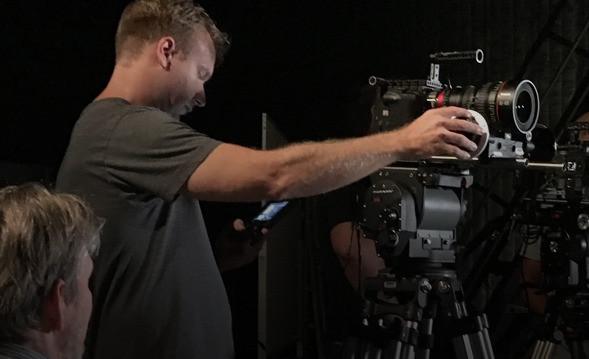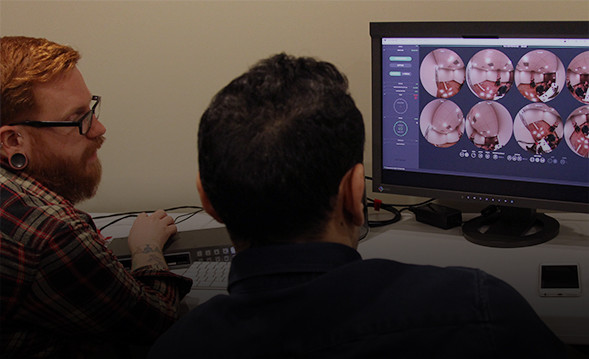Overview
Advanced Digital Cinema: Exposing for Log
Advanced Digital Cinema is our new series that teaches the key building blocks of technical knowledge needed to advance your career in the Camera Department. This series combines on-demand (asynchronous) materials and live classes delivered on the Smashcut virtual learning environment. (Learn more about Smashcut below.)
This class covers the principles of exposing with a log camera and is comprised of 4 chapters covering just over 4 hours of content. Each section of the class builds upon the previous ones, so we recommend reviewing each section in succession.
Chapters in this series include:
|
Chapter |
Format |
|
Understanding Scopes |
On-demand |
|
Color & Gamma |
On-demand |
|
Intro to LUTs |
On-demand |
|
Exposing for Log |
Live virtual - December 17 |
A full description of each section is outlined below.
Understanding Scopes
This section covers the use of waveforms and vectorscopes on set and demonstrates the use of many other tools used by modern digital cinematographers, including false color, zebra lines, and histograms.
Understanding Scopes is designed to give both a technical and practical knowledge of how these tools are used.
Topics include:
- Understanding the waveform
- Reading the waveform
- Sweep, display modes, calibration
- Live examples
- Understanding the vectorscope
- Gain and calibration
- Live examples
- Other video analysis tools
- Off color / cine zones / false color
- Zebras
- Histograms
Color & Gamma
Color Science is an often discussed topic today and something that every modern cinematographer and editor should understand. This section goes into the theory and reality of color, including how color and brightness are created both in our eyes and in the digital world. You will learn about color space, color gamut, sub sampling, bit depth, luminance, brightness, and gamma curves. Special attention is paid to the color systems and gamma modes used in the latest cameras.
Topics include:
- Color in our head
- Rods and cones
- Intensity vs brightness
- Color space
- Color gamut
- XYZ color space
- Rec709 and wide gamuts
- Color model
- Color reductions
- Subsampling
- Bit depth
- Understanding luminance
- Y matters
- Contrast and gamma
- Gamma and log
- Conversions between standards
- Color in camera
- ARRI, Sony, Canon, and Rec709 cameras
Intro to LUTs
Many of the latest camera systems offer either Log or Raw recording modes that give us the most possible information out of the camera. These features are great at keeping the original camera 'negative' as clean as possible, but at the same time they can leave your image on set looking very flat and boring. This is where the use of Look Up Tables (LUT) comes in, which are offsets that allow you to manipulate your image and create a look without affecting the camera originals.
Exposing for Log
Learn how camera sensors transform light into digital files, how exposure decisions affect the final image, and gain an overview of post production workflows.
Digital cinema camera systems are based on humans' visual processing abilities. This class explores the connection between these two imaging systems and how camera sensors capture light, which becomes a digital file. The class will explore the process of transforming the electromagnetic spectrum into camera files, along with the implications of exposure decisions. Particular emphasis will be placed on how data is quantified and its effect on images.
Attendees will become familiar with the various tools used by cinematographers and technicians to optimize exposure. The class will give an overview of post production workflows, include both traditional and ACES workflows in DaVinci Resolve.
Topics include:
- Human visual system
- Digital signal processing
- Quantifying data and exposure
- Log image processing
- Knowing the limits – manufacturers' values for exposure
- Tools for exposure
- RAW capture vs. Log capture
- Rating a camera
- Post workflow overview
- Traditional color correct workflow
- ACES (Academy Color Encoding System) workflow
Class Details
This class includes all on-demand and live instruction described above and delivered on the Smashcut platform. Smashcut is an online learning environment, designed especially for media education, that offers robust collaborative instruction with media sharing capabilities, contextual feedback on student work, and broadcast-quality asychronous video lectures. Once students have registered for this course, they will be granted access to Smashcut where they can watch on-demand lessons and the live instruction.
***BUNDLE DISCOUNT: We are currently offering a special bundle price of $595 for all four of our live stream Advanced Digital Cinema workshops. If you plan to take all four live stream classes, please contact training@abelcine.com to purchase at the discounted rate.***















![Advanced Digital Cinema: Exposing for Log [PROMO]](https://abelcinesalesforce2.s3.amazonaws.com/item/AB-TC-DFF-EXPOSING-LOG/advanced-digital-cinema-log2_v1.png)



